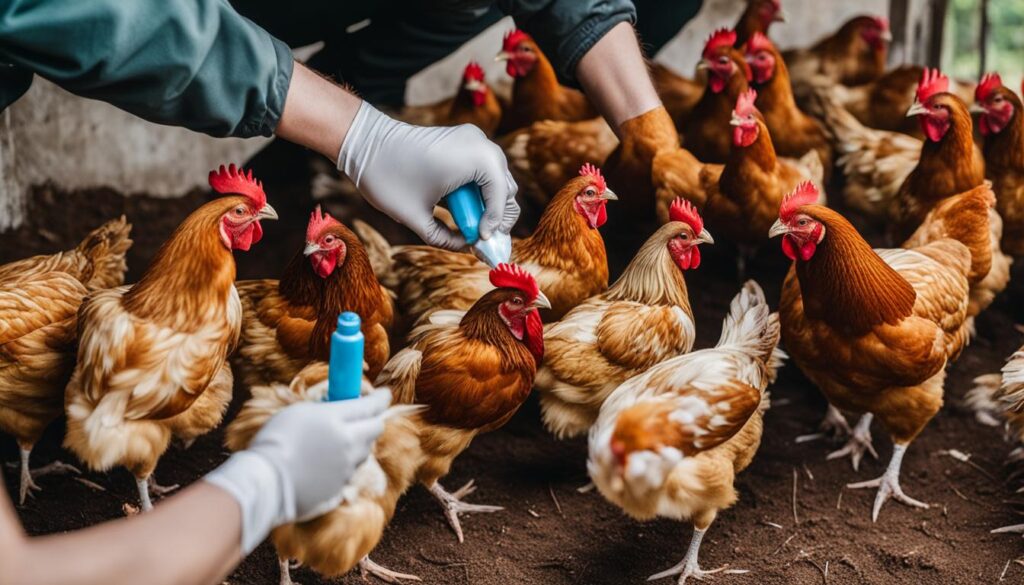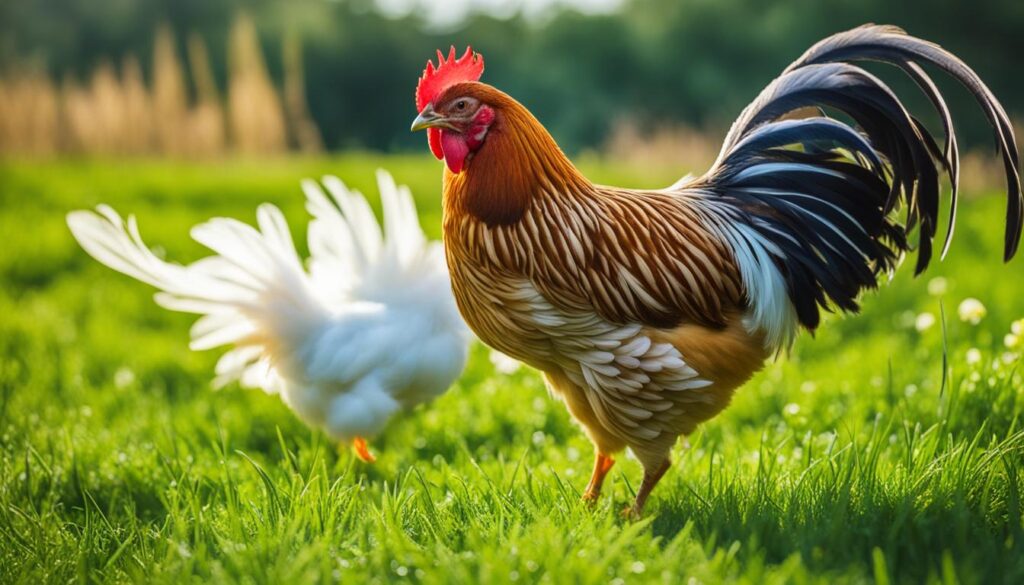As someone deeply embedded in the world of backyard poultry care, I have come to understand the delicate balance required in maintaining chicken health. One of the key components in assuring the well-being of my feathered friends is the administration of effective poultry medication. Specifically, finding the right denagard for chickens dosage is critical to prevent disease and sustain a thriving flock. I’ve spent years perfecting this aspect of care, and it fills me with pride to share this knowledge with fellow hobby farmers. It’s my intention to provide you with practical guidance that I have honed through experience, making sure your chickens flourish under your watchful eye.
In aligning with this goal, I want to highlight the importance of responsible medication. Over the years, I’ve learned that understanding the specifics of a drug like Denagard is not just beneficial, but necessary for your chickens’ health. It’s not merely about following instructions; it’s about embodying the role of a steward for the living creatures in your care. Let me walk you through the journey of ensuring that your backyard flock receives the correct dosage of Denagard, ensuring the sustained health and productivity of your chickens.
Key Takeaways
- The importance of the correct Denagard dosage for the welfare of backyard chickens.
- Experience-based insights on administering Denagard to prevent and treat diseases.
- How precise Denagard dosing contributes to maintaining chicken health.
- Understanding the weight-based guidelines for Denagard dosing.
- Encouragement for hobby farmers to adopt best practices in backyard poultry care.
- Personal commitment to sharing knowledge that ensures the thriving of backyard flocks.
Understanding Denagard and Its Importance for Chicken Health
As a seasoned backyard poultry enthusiast, I’ve learned that maintaining the health of your flock is crucial. That’s where Denagard antibiotics come into play. This medication isn’t just for curing illnesses; it’s a cornerstone of poultry health management. Let’s dive into what Denagard is and how its unique mechanism of action makes it indispensable for preventing chicken diseases.
What is Denagard and How Does it Work?
In the realm of backyard poultry care, Denagard stands out as a trusted ally against bacterial infections. Its role is significant in the fight against respiratory diseases, where it disrupts the protein synthesis of bacteria, effectively stopping the infection from spreading. The Denagard mechanism of action is specific enough to target harmful pathogens while being gentle on your chickens, ensuring rapid recovery without undue stress on your birds.
Benefits of Using Denagard in Your Backyard Flock
My experience with Denagard has shown me that it does more than heal—it’s a preventive measure that can save your chickens before they fall ill. By safeguarding against disease, Denagard supports not just the health but also the growth of your chickens. This is particularly beneficial for hobby farmers who value resilience in their flocks. An investment in Denagard is an investment in the long-term vitality and productivity of your poultry.
Recognizing Symptoms That Call for Denagard Treatment
Be vigilant for signs of bacterial infections in poultry, such as chicken respiratory disease symptoms. A cough or a wheeze, reduced appetite, and a general state of lethargy can all point to underlying health issues. It’s by recognizing these early symptoms that we can intervene with Denagard, ensuring our cherished backyard chickens get the timely care they need to thrive.
| Health Indicator | Healthy Chicken | Chicken Needing Denagard |
|---|---|---|
| Respiratory Sound | Quiet breathing | Coughing or wheezing |
| Appetite | Regular eating habits | Decreased interest in food |
| Activity Level | Active and alert | Lethargy or listlessness |
Remember, our role as caretakers is not just to react to sickness, but to preempt it wherever possible. That means keeping a close eye on your flock and integrating Denagard into your backyard poultry care regimen wherever necessary. Your chickens depend on you to keep them healthy, so arm yourself with knowledge and be proactive in preventing chicken diseases.
Denagard Dose for Chickens: Getting It Right
As a hobby farmer, I understand the concern and care that goes into looking after our feathery friends. It’s crucial to calculate Denagard dosage accurately to ensure the health and productivity of your chickens. The key to administering an effective Denagard dose for chickens is to adhere to the recommended milligrams per kilogram of body weight, making sure you are contributing to accurate dosing for poultry health.
Let’s break down the details of calculating the correct Denagard dosage for your backyard flock. The formula is simple: you take the weight of your chicken and multiply it by the recommended dosage, which can usually be found on the product label or through a veterinarian’s advice. Here’s an example table illustrating what this might look like:
| Chicken Weight | Denagard Dosage (Per Kg Body Weight) | Calculated Oral Solution |
|---|---|---|
| 2 kg | 10 mg/kg | 20 mg |
| 3 kg | 10 mg/kg | 30 mg |
| 4 kg | 10 mg/kg | 40 mg |
| 5 kg | 10 mg/kg | 50 mg |
But remember, it’s not just about the numbers; the health and safety of your chickens come first. I always suggest double-checking the calculation and observing your chickens closely after administering Denagard. Any signs of distress or adverse reactions should be noted and addressed swiftly.
By understanding these dosing guidelines, you play a significant role in safeguarding the welfare of your flock. As a fellow poultry enthusiast, I’m always here to share insights and experiences that could benefit our communal journey in backyard poultry care.
Administering Denagard: Best Practices for Hobby Farmers
As someone who deeply cares for the well-being of my chickens, I’ve come to discover that administering Denagard correctly is crucial for their health. Let me share with you some tried and true tips on how to give Denagard to ensure your flock stays healthy and happy.
Mixing Denagard with Drinking Water: One of the easiest ways to administer Denagard is by diluting it in your chickens’ drinking water. This method ensures a more uniform distribution of the medication among your flock. Here’s what I’ve found works best:
- Ensure you have fresh water in a clean container.
- Follow the manufacturer’s instructions to measure the correct amount of Denagard.
- Stir the solution properly to disperse the Denagard evenly.
- Provide the medicated water as the only water source during the treatment period.
Adding Denagard to Chicken Feed: Administering Denagard via feed is also an option. It requires a bit of precision, but the effort is worth it:
- Measure the appropriate quantity of Denagard as per the feed manufacturer’s recommendations.
- Mix thoroughly with feed to ensure even distribution.
- Monitor your chickens to make sure they’re consuming the feed properly.
Safety First: Always use protective gloves when handling any medication, including Denagard, to prevent skin irritation and accidental ingestion.
It’s essential to respect the treatment schedule for Denagard as skipping doses or ending the treatment early can lead to drug resistance in the bacteria. Here’s my routine for keeping track:
- Set reminders for each dose throughout the treatment.
- Keep a log of when you administer the Denagard to track the treatment course.
- Observe your chickens regularly for symptom improvement.
Remember, it’s important to always follow Denagard administration tips from credible sources and adhere to the specific needs of your flock. For any uncertainties, don’t hesitate to reach out to a poultry veterinarian.
By adopting these best practices for Denagard administration, you are taking active steps towards maintaining the health and vigor of your backyard flock.

The Impact of Dosage Accuracy on Chicken Well-being and Productivity
As a hobby farmer committed to the welfare of my poultry, I’m acutely aware that the risks of incorrect Denagard dosing can carry serious consequences for my flock. Let’s delve into how improper dosages can adversely affect our feathered friends.
The Consequences of Over or Under-Dosing
It’s a fine balance when it comes to medicating our birds. Over-dosing may lead to toxicity, potentially causing irreparable harm to a chicken’s internal organs. Conversely, under-dosing can further antibiotic resistance in bacteria and fail to alleviate the illness, compelling the bird’s condition to deteriorate. Needless to say, such inaccuracies can severely impair poultry health improvements we all strive for.
Maintaining Optimal Health with Precise Denagard Dosages
Aiming for optimal poultry health and growth, precise dosing isn’t just good practice; it’s essential. Following the proper poultry medication dosages prevents disease effectively and sustains flock productivity. In addition, observing these guidelines assures me of the Denagard precise dosing benefits, ensuring that every bird receives just the right amount for its size and condition.
Real-Life Examples: Success Stories from Correct Dosage Application
My experience with careful dosing has repeatedly yielded Denagard treatment success. One instance particularly stands out when I meticulously calculated and administered Denagard to my ailing flock. Not only did they recover, but they also thrived, exhibiting remarkable poultry health improvements. This instance echoes many testimonies from fellow farmers who witnessed substantial health benefits from precise medication dosing.
It’s remarkable how a seemingly simple practice of precise dosing can lead to significant impacts on chicken well-being and productivity. Here’s a table that resonates with this truth, drawing from my records:
| Dosage Accuracy | Impact on Health | Impact on Productivity |
|---|---|---|
| Correct Dosage | Improved recovery rates from illness | Increased egg production and growth |
| Over-Dosage | Potential organ damage | Decreased productivity due to health complications |
| Under-Dosage | Increased disease persistence | Stunted growth and reduced egg laying |

To all my fellow hobby farmers, I encourage you to invest time in learning the exact dosages for Denagard. It’s a small step that pays off in fostering a thriving and productive flock.
Monitoring and Adjusting the Denagard for Chickens Dosage Over Time
Maintaining the health of your backyard flock is an ongoing responsibility that requires diligent observation and periodic adjustments to their care regimen. Monitoring chicken health is crucial for ensuring the Denagard dosage remains effective over time. Subtle shifts in flock behavior or an apparent increase in disease occurrence could signal that a dosage reassessment is necessary. As someone who vigilantly watches over the well-being of my chickens, I’ve identified certain patterns and signs suggesting when an adjustment might be in order.
Signs Your Flock Might Need a Dosage Adjustment
Vigilance is key to identifying the need for any change in medication levels. By observing your flock daily, you might notice alterations in activity levels, feeding patterns, or overall demeanor that are out of character. Based on my experience, such changes could indicate that the current Denagard dosage needs a review. This is part of effective poultry medication dosages and health management; it’s essential to sync the treatment with the evolving needs of your flock to maintain optimal health.
When to Consult a Veterinarian for Dosage Changes
Though experience will equip you with the knowledge to make many decisions regarding your flock’s health, professional medical advice for chickens is indispensable. Whenever in doubt about adjusting Denagard dosage, seeking a poultry veterinarian consultation is the most prudent step. They can provide a definitive answer, grounded in veterinary science, ensuring that your flock receives the best possible care. I’ve found it extremely beneficial to have a trusted vet assess my chickens whenever I suspect that a Denagard dosage alteration might be needed.
The Role of Regular Health Checks in Dosage Determination
Preventive measures are the cornerstone of long-term poultry health. Regular poultry check-ups are a practice I cannot recommend enough, allowing for early detection and intervention should health issues arise. These check-ups also play a pivotal role in dosage determination for chicken health, as they can help ascertain whether the Denagard administration is still at an optimal level. In my routine, these health assessments are invaluable for maintaining a thriving and productive backyard flock.
